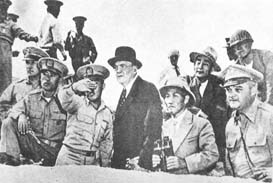
Dulles making final examination of the plan of invasion of
Who Started the Korean War?
The Korean war
broke out on June 25 1950.
Taking advantage of the end of WWII
and
The then
Accordingly, G-3 and G-2, research
groups involving KATO secret service staffed with former Japanese brass hats, were
formed in the MacArthhur Command to study an
operations plan and intelligence activities for war.
They drew up the ABC plan for the
invasion of the
On the basis of ¡°Plan A¡± the
The plan was designed to land on the
east and west coasts while breaking through the 38th parallel
head-on to occupy
The ¡°northward expedition¡± envisaged
launching all the ground and naval operations under the backing of the US Naval
Air Force.
After examining and revising the war
scenario between late 1949 and early 1950, the
The plan that was ratified by the US
National Security Council on April 2 1950 included the issues of committing the
To expand its forces that would be the
mainstay in the war the
Just before the war the south Korean puppet army expanded into a 100 000-strong army
including 93 000-strong ground force, 3 000-strong air force and 15 000-strong
naval force.
In addition, the Youth Defense Corps,
a reserve involving more than 200 000 young people, and the Student Defense
Corps involving middle school students were formed.
A Western publication reported at
the time that 1.25 million south Korean young people
received military training according to the
Regarding it as a prerequisite for
war preparations to take control of the south Korean
army, the
The Americans signed the
Transitional Temporary Status of Forces Agreement on Military Affairs and Security
with Syngman Rhee.
Having taken the command of the
puppet army and jurisdiction over its military bases and facilities, the
Americans provided it with a huge amount of military aid, weapons, combat and
technical equipment, warships and aircrafts.
Most of the south
Korean forces armed with the help of the
This is evidenced by American book ¡°History
of the Korean War¡± which said that when the

Dulles making final examination of the plan of invasion of
the DPRK in a trench along the 38th parallel (June 18, 1950)
To mobilize the
This shows that the
On the basis of such preparations
the
Although they failed in the war the
Americans are still pursuing the anti-DPRK policy to realize their wild
ambition to conquer it.
Due to their desperate bid to form
the international encirclement ring to isolate the DPRK under the pretext of
its recent satellite launch for peaceful purposes the Korean Armistice
Agreement has been abrogated and the constant danger of war hovers on the
The DPRK that is fully ready to
respond to the
The